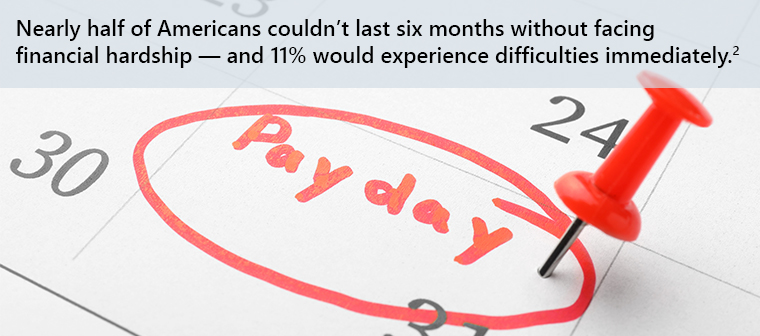Imagine sitting at a casino table, dice in hand. You’re hoping for that perfect roll — the one that brings a win. But you know the odds are never entirely in your favor. That’s the same gamble millions of working Americans take every day by not protecting their most valuable asset: their ability to earn an income.
Going without income protection is like rolling the dice with your financial future. Both involve risk, uncertainty, and the potential for significant losses. But unlike a casino game, the stakes are your lifestyle, savings, and long-term financial security.
The chances of experiencing a disabling illness or injury during a career are substantial. According to the Social Security Administration, one in four 20-year-olds today will face a disability that prevents them from working for at least a year before they retire.¹ This underscores the importance of having disability insurance. Often described as paycheck protection, it helps replace a portion of lost income during a qualifying disability — potentially preventing the need to deplete savings or incur debt.
The Real Odds
Disabling illnesses and injuries are more common than many clients realize. Yet, this risk often goes unaddressed in financial planning. That’s where financial professionals play a critical role. Disability insurance isn’t just for those with physically demanding jobs. It’s for anyone who depends on a paycheck — whether working behind a desk, treating patients, teaching, or running a business.
Without income protection, there’s a gaping hole in the plan. What happens if a client can’t work for six months, a year, or longer? For most households, the math simply doesn’t work without that paycheck.

Rolling the dice without disability insurance isn’t just a financial risk. It’s emotionally draining. A serious illness or injury can bring anxiety, fear, and tough questions:
- How will I pay the mortgage?
- Will I lose my business?
- Can I still support my family?
Disability insurance offers more than income replacement. It provides clients with peace of mind and the ability to focus on recovery instead of financial survival.

Reframe the Conversation: Income Protection, Not Disability Insurance
The term "disability insurance" often falls flat. Instead, position it as income protection. Clients understand that. It's not about worst-case scenarios — it's about protecting their lifestyle.
A simple, powerful question can open the door: "How are you protecting your income?" It reframes the conversation from hypothetical health issues to the real-world role their paycheck plays in achieving financial goals.
Avoiding the conversation isn’t a safe play — it’s a gamble in itself. By not bringing it up, you risk leaving your client vulnerable and the plan incomplete. Income protection should be as fundamental as life insurance. Financial professionals who present both together — not as an afterthought — see greater success.
When explaining the coverage, start with a good, better, best structure. Something is always better than nothing, and the best policy is the one that’s in force when it’s needed.

Evaluate Group Coverage
Ask your clients to share their employee benefits booklet with you. Most don’t fully understand what their group plan actually covers — giving you a valuable opportunity to educate and advise.
Individuals often assume employer-provided disability coverage is enough. It usually isn’t.
Group plans typically:
- Cover only base salary, excluding bonuses or commissions
- Cap monthly benefits at relatively low levels
- Provide taxable benefits if the employer pays the premium
- Are not portable if the employee leaves the company
A client earning $350,000 could end up with a $6,000/month taxable benefit — far below their lifestyle needs. And that's if the policy pays out smoothly.

Disabled Doesn’t Mean Bedridden
Many clients think disability means a catastrophic accident — resulting in paralysis or a coma. In reality, over 90% of disability claims are illness-related, not injury-based.
Cancer, heart disease, Multiple Sclerosis, Parkinson’s disease, depression, anxiety, addiction, and diabetes are among the leading causes. These illnesses and conditions may not be visible, but they can prevent people from performing their jobs.
Consider:
- A trial attorney suffering cognitive decline
- A financial advisor battling severe depression
- A surgeon developing a tremor
- A teacher undergoing chemotherapy
These individuals may appear outwardly healthy but cannot perform the critical tasks their roles demand.
There are thousands of medical conditions that can lead to disability. Clients don’t need to be completely disabled to qualify for benefits — they just need to be unable to do their job.

Broaden the Target Market
Disability insurance isn’t just for doctors and dentists. Attorneys, engineers, architects, IT professionals, real estate agents — anyone who relies on an earned income is a strong candidate.
And don’t overlook middle-income earners. Those making $50,000 a year often have less savings and thinner financial cushions, making them even more vulnerable to the impact of lost income.
Start with your current book of business. Look for clusters — shared employers, industries, or roles. Use that common ground to introduce the income protection conversation.
Don’t Wait for Clients to Ask
Clients rarely bring up disability insurance. They don’t know what they don’t know. It’s your responsibility to initiate the conversation. As their financial professional, you’re not just there to help them grow wealth — you’re there to help them protect it.
Start with practical, relatable questions:
- “What would happen if you couldn’t work for six months?”
- “How long would your emergency fund last?”
- “What’s your plan if a medical condition sidelines you for a year or longer?”
Then, offer solutions. Lean on our Crump Disability Solution Center team for support. Walk clients through key terms, like elimination period, benefit duration, and own-occupation definitions. Use real-world examples to make the information relatable. Most importantly, make it manageable. The goal isn’t to overwhelm — it’s to empower informed decisions.

Bottom Line
Don’t let your clients leave it to chance. Don’t let them leave their most valuable asset uninsured. We insure homes, cars, and phones without blinking. Yet, many overlook protecting the one thing that funds everything else.
Your clients won’t always know to ask about disability insurance or income protection. That’s why you have to bring it up. Have the conversation. Ask the tough questions. Use the resources available to you. Show your clients how to safeguard their paychecks — and their futures.
Contributors

Anna Bowden-Armenta is a Wholesaler at Crump Life Insurance Services. She has been with Crump for over 30 years. During her tenure, she has learned about all facets of the disability insurance industry by working in almost every area of the Crump Disability Solution Center. Today, Anna works directly with financial professionals to educate and promote income protection to their clients.

Kenny Russell is the Director of the Crump Disability Solution Center. He has been with Crump for over 20 years and is passionate about raising awareness about the income protection gap. Kenny leads a team of wholesalers; together, they educate countless financial professionals and clients on the importance of disability insurance and flexible product design to meet all client needs.